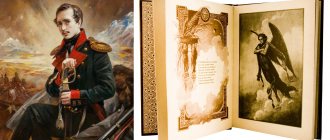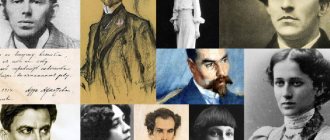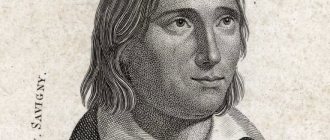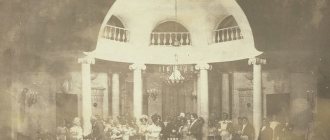Photo: UGC Lermontov's biography is full of interesting life turns, despite the fact that the poet was only a few months short of his 27th birthday. He managed to study at the university, serve in the army, become the personal enemy of the tsar and earn the fame of the second brilliant poet after Pushkin. I’ll tell you more about the life and work of Lermontov.
M. I. Glinka (1804-1857)
A great Russian composer who played a huge role in the development of Russian classical music. Having summarized the achievements of his predecessors, he laid the foundations of a national musical style and opened, like Pushkin in literature, the classical period in the history of Russian music. Glinka's creativity reflected the advanced aspirations of the time. His art is brought closer to the freedom-loving poetry of Pushkin and the Decembrists by humanism and the ideas of patriotic service to the people.
Glinka's operas are of greatest importance, truthfully recreating the heroism of the historical past, the romance of the national epic. The subtle lyricism of romances reveals a world of feelings full of beauty. Picturesqueness and colorfulness are characteristic of his symphonic works. Having discovered an inexhaustible source of poetry in folk songs, Glinka created a truly democratic national art.
The creation of the opera “Ivan Susanin” (1836) was of great importance for the further development of Russian musical culture. The composer's second opera, Ruslan and Lyudmila (1842), was marked by high creative maturity. The images of folk poetic fantasy, captured in Pushkin's youthful poem, were embodied in Glinka's opera on a truly epic scale. During the years of work on “Ruslan and Lyudmila”, music was also written for N.V. Kukolnik’s tragedy “Prince Kholmsky” (1840) and numerous romances.
Report on Pushkin
Countless studies have been written about Pushkin, the genius of Russian literature, “the sun of Russian poetry.”
Pushkin was born on May 26, 1799 in Moscow, in the German settlement. His father Sergei Lvovich Pushkin (1770-1848) was a secular wit and amateur poet. Pushkin's mother is Nadezhda Osipovna (1775-1836), granddaughter of Hannibal.
It seems that everything is known about him. About his origin - there were important historical figures in his family; about Uncle Vasily Lvovich Pushkin, who was friends with the most prominent writers; that Sasha was the unloved child in the family, and his nanny Arina Rodionovna was mainly involved in raising him.
It is known that the family spoke French, and the future great poet, who learned to read and write early, also composed his first poems in French. He spoke this language so well that while studying at the Lyceum, his comrades called him “French”. At that time, the nobles lived in Russia as if in a foreign country: children were raised in a European way, they adopted foreign fashion, they imitated foreign writers... It is no coincidence that Pushkin says about his beloved heroine, Tatyana from the novel in verse “Eugene Onegin”: “She The girl seemed like a stranger to her own family...” She seemed alien most of all because she was “Russian in soul.” Of course, everyone also knows that the poet’s talent was fully revealed back in the Tsarskoye Selo Lyceum, where “old man Derzhavin noticed us and, going to his grave, blessed us.”
We also know about Pushkin’s lyceum friends, the most talented young men of that time, future famous military leaders, ministers, writers, Decembrists:
Ivan Ivanovich Pushchin, Anton Antonovich Delvig, Wilhelm Kuchelbecker. No matter how much the Decembrists protected the poet from participating in anti-state affairs, when asked by the Tsar where he would have been on December 14, 1825, Pushkin boldly replied that he would have been on Senate Square.
Stormy life, constant lack of money, exile, more like imprisonment, insults from prosperous mediocrities, and at the same time - true friends, wife - Natalya Nikolaevna Goncharova - the first European beauty - and inspired creativity...
Pushkin went through the period of apprenticeship so quickly and so quickly became uniquely original, with such outward ease he created NEW things, unprecedented before him, that he was far ahead of his time. And this is a sign of genius! “Ruslan and Lyudmila”, “Poltava”, “The Tale of the Fisherman and the Fish” and other fairy tales, “Belkin’s Tales”, “The Queen of Spades”, “The Captain’s Daughter”, “Eugene Onegin”, “The Bronze Horseman” - all these are great innovative works. Pushkin's work is a great Russian heritage. The greatness of Pushkin lies in the fact that, better than any ruler, he united the Russian people, forcing them, first of all, to speak the same language. He was a brave and impeccably sensitive transformer of the native language; in the mouths of his heroes, previously dry and largely outdated speech came to life, shone and entered the everyday life of every person. Pushkin is a poet who is really read. To feel the magic contained in just two lines, igniting the imagination and exciting endlessly: I remember a wonderful moment, you appeared before me... Pushkin’s duel with Dantes took place on January 27, 1837 on the Black River. The shot mortally wounded the poet, and he died on January 29.
Alexander Sergeevich Pushkin was buried on the territory of the Svyatogorsk Monastery in the village of Pushkinskie Gory, which is located not far from the poet’s family estate - the village of Mikhailovskoye. In August 1841, a snow-white tombstone by sculptor Alexander Permagorov was installed on the grave.
Other interesting works on this subject:
Presentation “Alice in Wonderland translated by V. Nabokov”
Our presentation talks about Vladimir Nabokov's wonderful translation of Alice in Wonderland. In his translation, Nabokov introduced a Russian flavor into the plot of the book - even the names of the characters are Russian - Alice turned into Anya, the Cheshire Cat became the Maslant Cat, and parodies of the works of English classics became parodies of Russians.
Report on Maxim Gorky
A. P. Borodin (1833-1887)
An outstanding composer, a prominent chemist, a tireless scientific and public figure.
His musical heritage is small, but varied in content. The composer's interest in the heroes from the Russian heroic epic was reflected in the opera and two symphonies, impressive in power, strength, and majestic scope. Borodin created timeless examples of vocal lyrics. His musical style is marked by harmonic clarity, a tendency towards monumentality and classical completeness.
The composer's generous melodic gift was nourished by both Russian folk songs and oriental music. The performance of the First Symphony (1869) brought the composer public recognition. At the same time, two monumental works were conceived - the opera “Prince Igor” and the Second Symphony, which the critic V.V. Stasov later aptly called “Bogatyrskaya” (completed in 1876).
M. P. Mussorgsky (1839-1881)
A great realist composer, creator of bright, original, innovative art. His artistic views were formed under the influence of revolutionary democratic ideas of the 1860s. The musician saw his goal in a truthful portrayal of the life of the oppressed people, in exposing the social deformities of the autocratic serfdom system. He also pursued this goal when referring to turning points in Russian history. “The past in the present is my task,” said Mussorgsky. He had the gift of exceptionally deep and sensitive insight into the psychology of the people, which allowed him to create a gallery of living, uniquely original national characters.
The novelty of his ideas forced Mussorgsky to look for original forms and means of musical expression that enriched world art. The pinnacle of the composer's creativity was the musical drama "Boris Godunov" (1868-1872). The composer worked on the operas “Khovanshchina” and “Sorochinskaya Fair” (based on Gogol) until the end of his life. In the 1870s The ballad “Forgotten” was also created based on the plot of the painting of the same name by V. Vereshchagin, the cycle “Songs and Dances of Death” with words by A. Golenishchev-Kutuzov and the piano cycle “Pictures from an Exhibition” (1874).
N. A. Rimsky-Korsakov (1844-1908)
Outstanding composer, musical and public figure and teacher; left a huge creative legacy. It includes 15 operas, 3 symphonies, a number of orchestral works (among them the most popular are the symphonic suite “Scheherazade” of 1888 and “Capriccio Espagnol” of 1887), numerous romances and other works.
Rimsky-Korsakov also owns two collections of Russian folk songs, the fundamental work “Fundamentals of Orchestration,” a textbook on harmony, the informative “Chronicle of My Musical Life,” articles and notes on various issues of musical art. A meticulous study of Russian folk songs allowed the composer to create the famous operas “May Night” (after Gogol, 1879) and “The Snow Maiden” (after Ostrovsky, 1881), which reflected Rimsky-Korsakov’s deep passion for national fairy tales and pagan mythology.
I. F. Stravinsky (1882-1971)
- Russian composer, conductor and pianist, a key figure in musical modernism, one of the largest representatives of world musical culture of the 20th century. Citizen of France (1934) and the USA (1945). Early ballets - “Petrushka” (1911), “The Rite of Spring” (1913) - are associated with Russian folklore and rituals. Stravinsky's work, despite its figurative and stylistic diversity, is distinguished by its integrity and organic connection with the traditions of Russian musical culture. Among the works of this composer are O (1914), “The Moor” (1922), “The Rake’s Progress” (1951), the choreographic cantata “The Wedding” (1923), the pantomime with the singing “The Tale about the Fox, Rooster, Cat and Ram" (1916), ballets "Firebird" (1910), "Orpheus" (1947), "Agon" (1957), as well as "Symphony of Psalms" (for choir and orchestra, 1930).
Biographies of children's writers. 1 part.
Hans Christian Andersen
1805 ─ 1875
Hans Christian Andersen or “the king of fairy tales” is what adults and children called the writer. And the boy was born on April 2, 1805 in the old Danish city of Odenes, in the family of a shoemaker. In the very center of the city, there is a house in which the Andersen family lived. This is where he spent his difficult childhood.
Christian grew up in love and care. The father took the boy to the forest, made toys and even made a real puppet theater for him. And he heard the first fairy tales from his father. The boy remade these tales in his own way and told them himself. The best listener of fairy tales was an old cat named Karl. But Karl often fell asleep without listening to the end of an interesting fairy tale. Christian was not angry with the old cat and forgave him everything.
One day the boy visited a real theater and fell in love with it for the rest of his life. But the tickets were very expensive and Christian could not go to the theater often. He then became friends with the man who puts up posters. And the poster is an announcement about the performance. Christian helped put up advertisements and was rewarded with a new poster. Christian brought the poster home and, having read the title of the play, immediately came up with his own.
Christian had a very good voice: he sang and recited poems. One day the future king of Denmark, a young prince, wanted to listen to the boy. Christian sang for him and then said that he would like to study. The future king did not like these words. “Don’t forget that you are from a poor family and it’s better for you to learn a craft,” he said sternly.
It won't be long before these two meet again. The prince will become a king, and the shoemaker's son will become a famous storyteller.
At the age of 14, Christian left his home and went to distant Copenhagen. And Copenhagen is the main city or capital of Denmark to become an actor.
He failed to become an actor, but he became a famous writer and storyteller.
Since childhood, we have known fairy tales: “The Ugly Duckling”, which turned into a beautiful swan. The tale of the ugly duckling is a description of the life of little Andersen, because he was also not very handsome in appearance and loved to dream. And as a child I felt like this little duckling.
And here is the princess and the pea. One of the first fairy tales that parents read to their daughters. It talks about a little princess, who even forty feather beds did not prevent her from feeling a pea.
And Andersen has a fairy tale “The Snow Queen”. This tale is about memories from childhood. Little Hans was childhood friends with a neighbor girl. They often played together on winter evenings and grew onions and parsley in a box. And the Snow Queen seemed to the boy when his father died.
Hans Christian Andersen was lonely all his life. He wanted to love, but he had no family, no children. Therefore, many of his tales of love are very sad.
For example, "The Little Mermaid". This is a good story about the strong love of a little mermaid for a prince, who is ready to give up life in the sea so that she can have a human soul and the love of a prince.
Or the tale of the tin soldier. One boy had a soldier. But the soldier did not have a leg. The boy liked the soldier: he stood on his one leg as firmly as the other soldiers and looked at the beautiful ballerina, dreaming of meeting her. And what happened next, you can read the fairy tale “The Steadfast Tin Soldier.” And many other interesting fairy tales were written by Hans Christian Andersen. Among them are “Thumbelina”, “Wild Swans”, “The Little Match Girl”.
Residents of Denmark are very protective of everything connected with the name of Andersen. Monuments to the writer and his heroes have been created in Denmark.
In Copenhagen, everyone is amazed by the Little Mermaid statue. The sad Little Mermaid looks into the distance, as if waiting for her beloved prince to appear. The Little Mermaid is a symbol of modern Denmark.
Andersen's birthday, April 2, is declared International Children's Book Day. And also, the International Prize was named after the great storyteller - this is a gold medal. The Andersen Prize is given to writers who have created the best books for children.
You can also learn about the life of the great storyteller by visiting the house museum in Copenhagen or Odense. The museums are located in the houses where the storyteller lived. In front of the entrance there is a monument to Andersen. Inside the museum you can see an office in which a wax figure of Andersen sits at a table. A huge number of paintings, drawings and sculptures related to the heroes of your favorite fairy tales are exhibited here.
The great storyteller, Hans Christian Andersen, is long gone. He died in 1875 and was buried in Copenhagen.
2
D. D. Shostakovich (1906-1975)
One of the largest composers of our time, an outstanding musical and public figure, teacher. His work represents all genres of musical art: opera and ballet, symphony and concert, instrumental ensemble and romance, song and oratorio, operetta and music for cinema and theater productions. Shostakovich's works are characterized by high civic spirit, acute conflicts, and emotional tension. The stunning, sometimes tragic contradictions of the modern world, the unceasing struggle between the creative and destructive forces of life, the bright humanistic ideals of freedom and justice have found in him a most talented interpreter.
Shostakovich's musical style is bright and original. His work was greatly influenced by Mussorgsky and Tchaikovsky, and among foreign composers - Mahler. Also, the creatively comprehended Russian folk song tradition plays a huge role in creativity. The opera "The Nose" (after Gogol, 1927-1928), the ballets "The Golden Age" (1930) and "Bolt" (1931), the Second ("Dedication to October", 1927) and the Third (" Pervomaiskaya”, 1929) symphonies, music for dramatic theater and cinema spoke about the attraction to topical themes and ideas, about the desire for novelty in musical language. The largest works are the opera “Lady Macbeth of Mtsensk” (1932; in the second edition - “Katerina Izmailova”, 1956), Concerto for piano, trumpet and string orchestra (1933), Fourth Symphony (1936). ).
Biographies of famous Russian writers and poets of the 19th - 20th centuries. card index on literature on the topic
| Mikhail Yurievich Lermontov (1814 – 1841) |
Mikhail Yuryevich Lermontov was born in 1814 into the family of a retired officer Yuri Petrovich and a representative of a noble family, Maria Mikhailovna, who died when the boy was two years old. Maternal grandmother E. A. Arsenyeva took the boy to her estate, in the Penza province, the village of Tarkhany. It was there that the future poet spent his childhood. The boy received a home education in the capital and spoke French and German from childhood. Already in Tarkhany, Lermontov’s keen interest in literature and poetic creativity was determined.
At the age of ten, Mikhail Lermontov first came to the Caucasus. From childhood, the future poet was imbued with special feelings for this region. He showed an early ability for versification, and has preserved poems and even poems written by him at the age of 14.
In 1827 the family moved to Moscow, and in 1828 Mikhail Lermontov was enrolled as a half-boarder in the 4th grade of the Moscow University Noble Boarding School, where he received a humanities education. Here, his first poem, “Indian Woman,” was published in a handwritten journal. At the boarding house, Mikhail Lermontov's predominant orientation towards A.S. Pushkin and the Byronic poem is determined. In 1828 – 1829 he writes poems: “Corsair”, “Criminal”, “Oleg”, “Two Brothers”, “The Last Son of Liberty”, “Ishmael Bey”, “Demon”. Already in Lermontov’s early works, the motive of rebellion, “thirst for freedom,” and the desire to fight appears, and then becomes more and more obvious. The poet creates the image of a lyrical hero, dissatisfied with life. The Byronic motif of loneliness, disappointment, and exile runs through all of Lermontov's poetry.
In September 1830, Mikhail Lermontov became a student at Moscow University in the moral and political department, and then in the verbal department, where he studied for less than two years. Lermontov's first strong youthful passion for E. A. Sushkova dates back to this time. The lyrical cycle of 1830 is associated with Sushkova - “To Sushkova”, “Beggar”, “Stanzas”, “Night”, “Imitation of Byron”, “I don’t love you: passions...”.
At Moscow University, Lermontov fails to pass public exams: the teachers did not forgive him for his daring behavior, and therefore, in order not to remain in the same course for the second year, Mikhail comes to St. Petersburg with his grandmother, hoping to transfer to a local university. However, his studies in Moscow were not taken into account, and he was offered to enroll again as a first-year student.
Lermontov experiences an even stronger, albeit short-lived, feeling for N. F. Ivanova, the daughter of the playwright F. F. Ivanov. During these years (1830 - 1832), the formation of the poet’s personality takes place, and changing love interests are in many ways an attempt at self-affirmation of the poet. The genre of “excerpt” emerges - lyrical reflection, in the center of which is a certain moment of continuously ongoing introspection.
Following the advice of a friend, on November 10, 1832, M. Lermontov entered the school of guard cadets and ensigns, where he spent, in his own words, “two terrible years,” filled with revelry, base hobbies, into which he plunged with all the strength of his rebellious soul. After graduating from school in November 1834 with the rank of cornet of the Life Guards, Lermontov was assigned to a hussar regiment located in Tsarskoe Selo.
Mikhail Yuryevich Lermontov’s first prose experience was the novel “Vadim,” written in 1832–1834. and presented a wide panorama of the peasant uprising of 1774 - 1775.
In 1835, the poem “Hadji Abrek” was published - M. Lermontov’s first appearance in print. The manuscript was taken by a distant relative of the poet N.D. Yuryev to the magazine “Library for Reading” secretly from the author. The poem was greeted warmly by readers, but the dissatisfied M. Lermontov refused to publish his poems for a long time.
Lermontov's first novels quite subtly convey the experiences of the youth of a writer with outstanding talent.
B – conflict between officer Grigory Pechorin and official Krasinski. Here the top of society is depicted more critically than was customary in secular literature of the time. At the same time, Lermontov was working on the drama “Masquerade” (1835 – 1836) - the first work that he considered worthy of publication, submitted to the dramatic censor three times and remade twice, however, the drama was banned.
In 1835 – 1836 Lermontov creates “Boyar Orsha” - the first original and mature poem. Orsha is Lermontov’s first attempt to create a historical character - a feudal lord of the era of Ivan the Terrible, living according to the laws of boyar honor. “The Song about Tsar Ivan Vasilyevich, the young guardsman and the daring merchant Kalashnikov” (1838) continued this theme in Lermontov’s work. A kind of analogue of “Song...” was “Borodino” - a response to the 25th anniversary of the Battle of Borodino (1837).
The poem “The Death of a Poet,” written in 1837 on the death of A. S. Pushkin, became a turning point in his biography. An outstanding literary talent was revealed to the public, and the revealing pathos of the work was perceived as an appeal to the revolution. The consequence of this was deportation to the active army in the Caucasus, to the Nizhny Novgorod Dragoon Regiment. The Caucasian period introduces the author to new people and life, completely different from the capital's secular one. Staying in his beloved lands had a fruitful effect on Lermontov, helped him find peace of mind, and even thought about retiring and staying here. But already in October of this year he returns to the big world and actively begins to publish in the magazines Sovremennik and Otechestvennye zapiski. Lermontov's stories, which were later included in the novel “A Hero of Our Time,” are also published.
1840 was a tragic year for Lermontov. His secret enemies handed the son of the French ambassador an epigram that the poet wrote several years ago and addressed to another person. But Barant was assured that Lermontov did it. A duel took place. Lermontov was found guilty and brought before a military court. On the instructions of the tsar, he was transferred to an infantry regiment in the Caucasus. Lermontov was sent to certain death. In the summer and autumn of 1840 he took part in bloody battles. In between battles he wrote poetry.
In 1841, Lermontov was given a short leave. He is going to St. Petersburg. But Nicholas I ordered Lermontov to be immediately expelled from the capital. Saying goodbye to St. Petersburg, he writes the famous poem “Farewell, Unwashed Russia.”
Mikhail Yuryevich Lermontov left for his destination; the route lay through Pyatigorsk, where Lermontov stayed. He found himself among aristocrats who quarreled between Lermontov and the retired major Martynov. On July 15, 1841, a duel took place between them at the foot of Mount Mashuk; Lermontov was killed. Later, his grandmother Arsenyeva transported her grandson’s ashes to Tarkhany and buried them in the family crypt, next to the graves of her ancestors.
"Glove". The ballad was written in 1829 and is an abbreviated translation of the ballad of the same name by F. Schiller (1797). The main idea that the poet asserts is the idea that true love does not need proof and that love can be destroyed by a rash act.
"Angel". A poem of religious and philosophical content about the connection between earthly and unearthly life. Written in 1831
The poem “Desire” was written in 1831 under the influence of a family legend about the Scottish ancestors of the Lermontovs.
“She is not proud of her beauty...” The poem was written in 1832 and addressed to V. A. Lopukhina; imbued with gratitude for the feelings that were given to the poet. Lermontov is attracted by the discreet beauty of his beloved, her modest simplicity.
In 1837, Lermontov was under arrest for writing poems on the death of A.S. Pushkin. The poet was placed in one of the rooms on the top floor of the General Staff building. Only the valet was allowed to see him. Lermontov ordered the bread to be wrapped in gray paper. On these scraps, using wine, stove soot and a match, he wrote the poems “When the yellowing field is agitated,” “Prayer,” “Neighbor,” and “Prisoner.”
In the poem “When the yellowing field is agitated...” the poet talks about his boundless love for his native land, about the beauty of Russia’s nature, dreams of a peaceful and calm life, of happiness on earth.
"Poet". The poem was written in 1838. The poet compares an expensive damask steel dagger trimmed with gold and the poet’s work, its purpose. The dagger once served its owner faithfully, tore more than one chain mail, and “ringed in response to offensive speeches.” Now decorated with gold, it hangs on the wall like a golden toy. Lermontov wonders whether the poet in the present century has lost his purpose, like this dagger: thoughts are not so noble, words are not so weighty and strong. In the poem one can hear an echo of Decembrist ideas about the poet as a people's leader.
"Thought". The poem was written in 1838. It contains a reproach for that part of the noble intelligentsia that is not capable of serving society. Lermontov met with exiled Decembrists in the Caucasus and disagreed with many of them in his assessment of the activities of the Decembrists themselves and the policies of Nicholas I. Exhausted by hard labor, exile, and soldiering, some participants in the uprising reconciled with the autocracy and recognized the struggle as useless. Lermontov calls these moods “their late mind.”
“How often surrounded by a motley crowd...” The poem was written under the impression of the New Year's festivities on the New Year of 1840. At one of the balls in the Assembly of the Nobility, I. S. Turgenev saw Lermontov. He recalled how at the ball the poet was given no rest, pestered him, they took his hands; one mask was replaced by another, and he almost did not move from his place and “silently listened to their squeak, alternately turning his gloomy eyes to them.”
The poem “Mtsyri” was written in 1839 and tells about the life of a monk. The original name “Beri” (from Georgian, meaning “monk”) was later replaced by Lermontov with “Mtsyri”, which means, firstly, “a non-serving monk, something like a novice” and, secondly, “an alien, a foreigner " “Mtsyri” reflects the usual Lermontov motifs associated with the flight of a romantic hero from his native places, where he is not understood, not recognized, to distant unknown lands. But in “Mtsyri” the opposite situation develops. Here the hero runs the other way around, to his homeland, and at the same time mysterious and unknown to him, since he was taken from there too young for clear pictures of it to be preserved in his memory.
"Hero of our time". The novel was written in 1838 – 1839. The original title was “One of the heroes of the beginning of the century.” A novel about a “modern man”, a representative of the younger generation of the 30s. 19th century When asked why smart and energetic people do not find use for their abilities, Lermontov answers with the story of Pechorin, the main character.
The novel consists of five stories: “Bela”, “Maksim Maksimych”, “Taman”, “Princess Mary”, “Fatalist”. Each story is an independent work of art; They are united by the image of Pechorin. Events are unfolding in the Caucasus: critically thinking people disliked by the government have been exiled there. The aimlessness of existence and spiritual emptiness lead the hero to the fact that he becomes an “extra person” in society.
P. I. Tchaikovsky (1840-1893)
A great composer whose name symbolizes an entire era in the history of world musical culture. His life is an example of continuous, persistent work. Tchaikovsky combined his fruitful work as a composer with the activities of a teacher, critic, publicist, and conductor. His work is deeply national: he created a gallery of wonderful images of Russian people, captured pictures of his native nature, and sang the glorious heroic past of Russia. A sensitive realist psychologist, Tchaikovsky reflected the spiritual world of his contemporaries with enormous emotional strength and vital truth.
The main idea of his work is protest and passionate struggle against the dark forces of life that erect obstacles on a person’s path to happiness. The program symphonic works “Romeo and Juliet” (1869) and “The Tempest” (after Shakespeare, 1873), as well as “Francesca da Rimini” (after Dante, 1876) outlined the tragic line that emerged especially clearly in the last years of the composer's life. By 1878, Tchaikovsky had completed the Fourth Symphony and the opera Eugene Onegin - works of genius that marked the flowering of his creativity and played a decisive role in the subsequent development of Russian opera and symphony.
Share link
Popular message topics
- Sights of China
The territory of China occupies a sufficient part of the land. This is where a rich culture and unique natural attractions originated. We know about China not only thanks to the emergence of Confucianism, the invention of gunpowder, - Sea of Azov
The Sea of Azov, washing the shores of Ukraine and Russia, extends to the south of the Russian Plain and is the smallest and shallowest sea in the world. Half of the Azov Sea has a depth of about 5 meters. The maximum depth is only 15 m. - Otto von Bismarck
History has many great personalities whose results are striking not only in their greatness, but also in their ambiguity. One of these was the prominent German political figure Otto von Bismarck.







